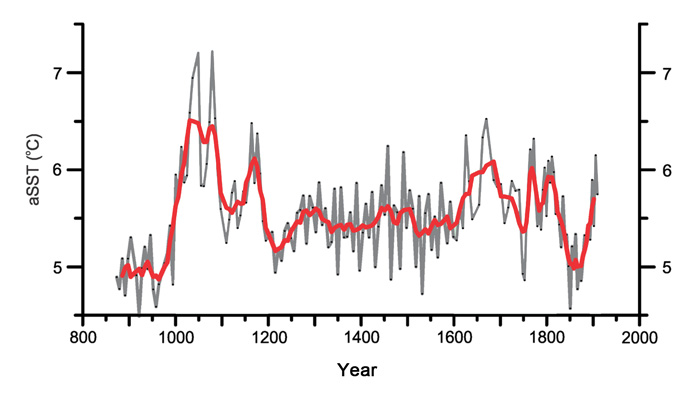| Follow @co2science |
Paper Reviewed
Miettinen, A., Divine, D.V., Husum, K., Koc, N. and Jennings, A. 2015. Exceptional ocean surface conditions on the SE Greenland shelf during the Medieval Climate Anomaly. Paleoceanography 30: 1657-1674.
In the introduction to their enlightening study, Miettinen et al. (2015) write that they "reconstructed August sea surface temperature (aSST) and April sea ice concentration (aSIC) at sub-decadal temporal resolution based on diatom assemblages found in sediment core MC99-2322 from the Kangerlussuaq Trough, SE Greenland shelf in order to investigate the variability of summer sea surface conditions along with possible forcing factors on the climatologically sensitive SE Greenland shelf during the last 1130 years."
As shown in the figure below, this work revealed, as the five researchers report, that "around 1000 C.E., aSST rises as much as ~2.4°C from 4.8°C (~995 C.E.) to the absolute record maximum of 7.2°C (~1050 C.E.) in the time span of only ~55 years, indicating a forceful onset of the warm conditions in the area." And they go on to state that "the clearly discernible warm period ~1000-1200 C.E. with the mean aSST of 6°C represents the warmest interval of the 2900 year long record [our italics]."
It is also illuminating to note that the atmosphere's CO2 concentration over the 1000-1200 C.E. period of maximum warmth on the SE Greenland Shelf was only about 280 ppm, while today it is over 400 ppm and growing ever higher. Yet global temperatures still have a considerable way to rise before they reach the level that prevailed during the record-breaking Medieval Warm Period, which further suggests that the atmosphere's CO2 concentration has a much weaker impact on global near-surface air temperatures than what is currently claimed to be the case by the world's climate alarmists.

High-resolution reconstructed August sea surface temperatures (aSST) from Kangerlussuaq Trough, SE Greenland shelf, over the interval 870-1910 CE. Adapted from Miettinen et al. (2015).




